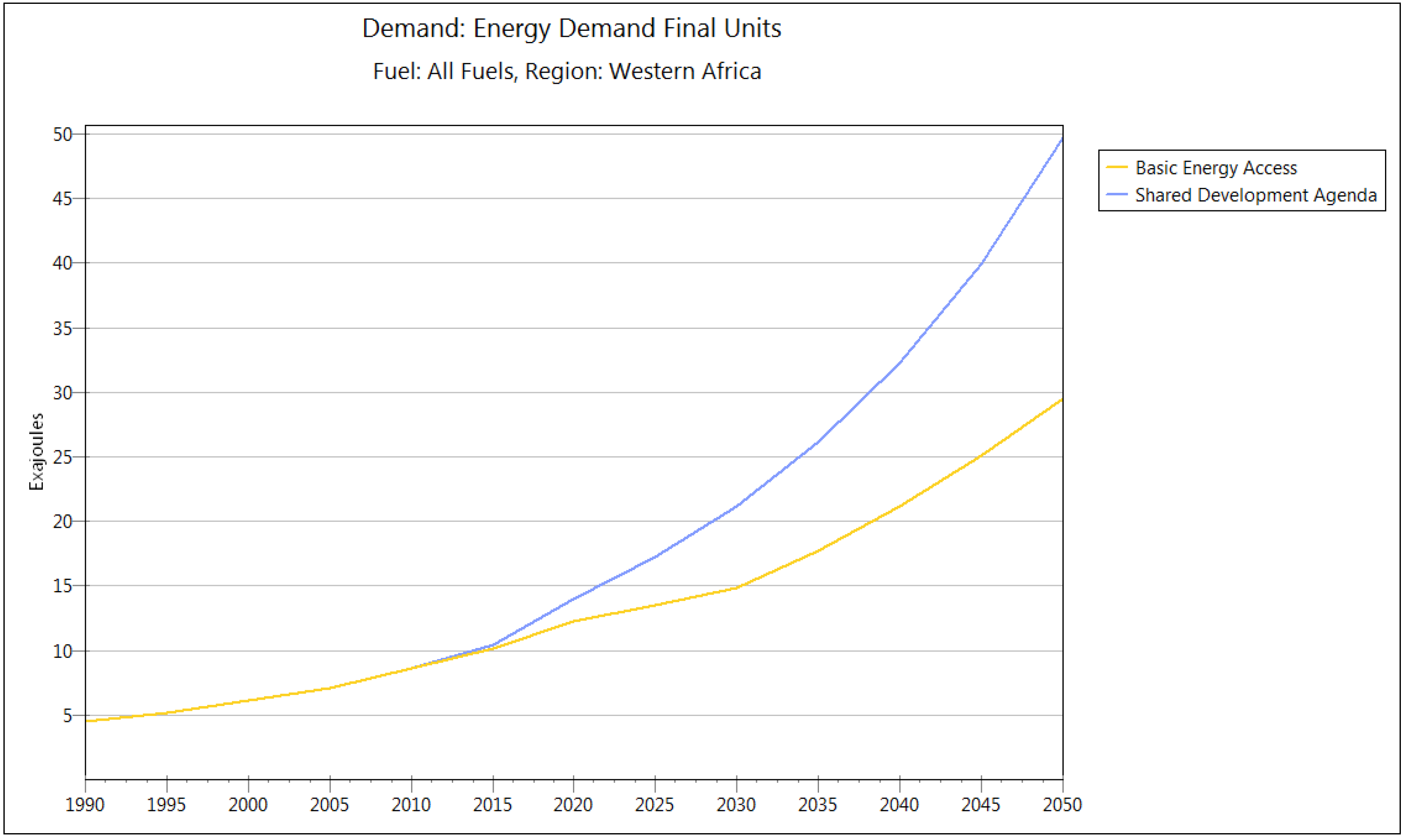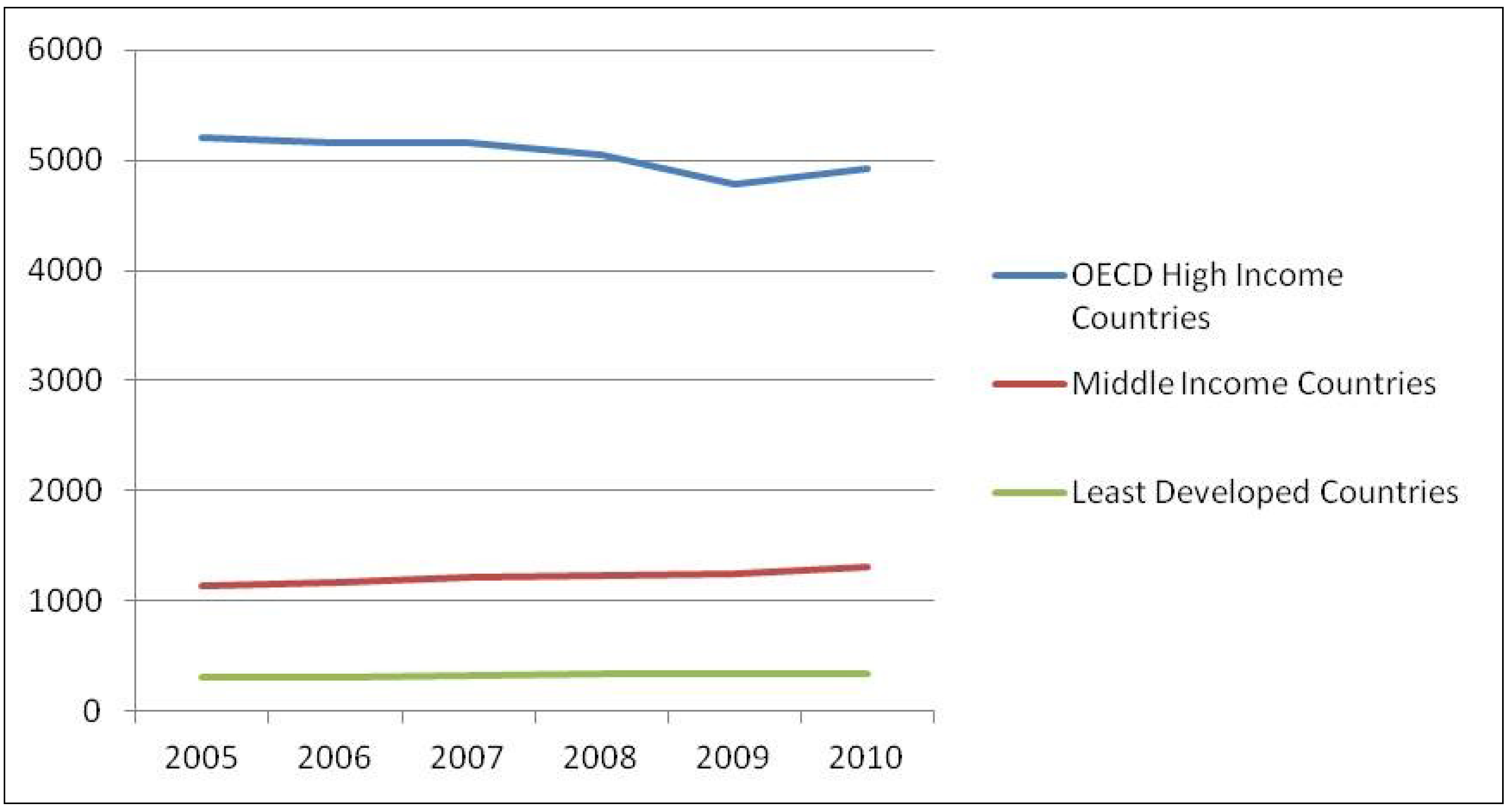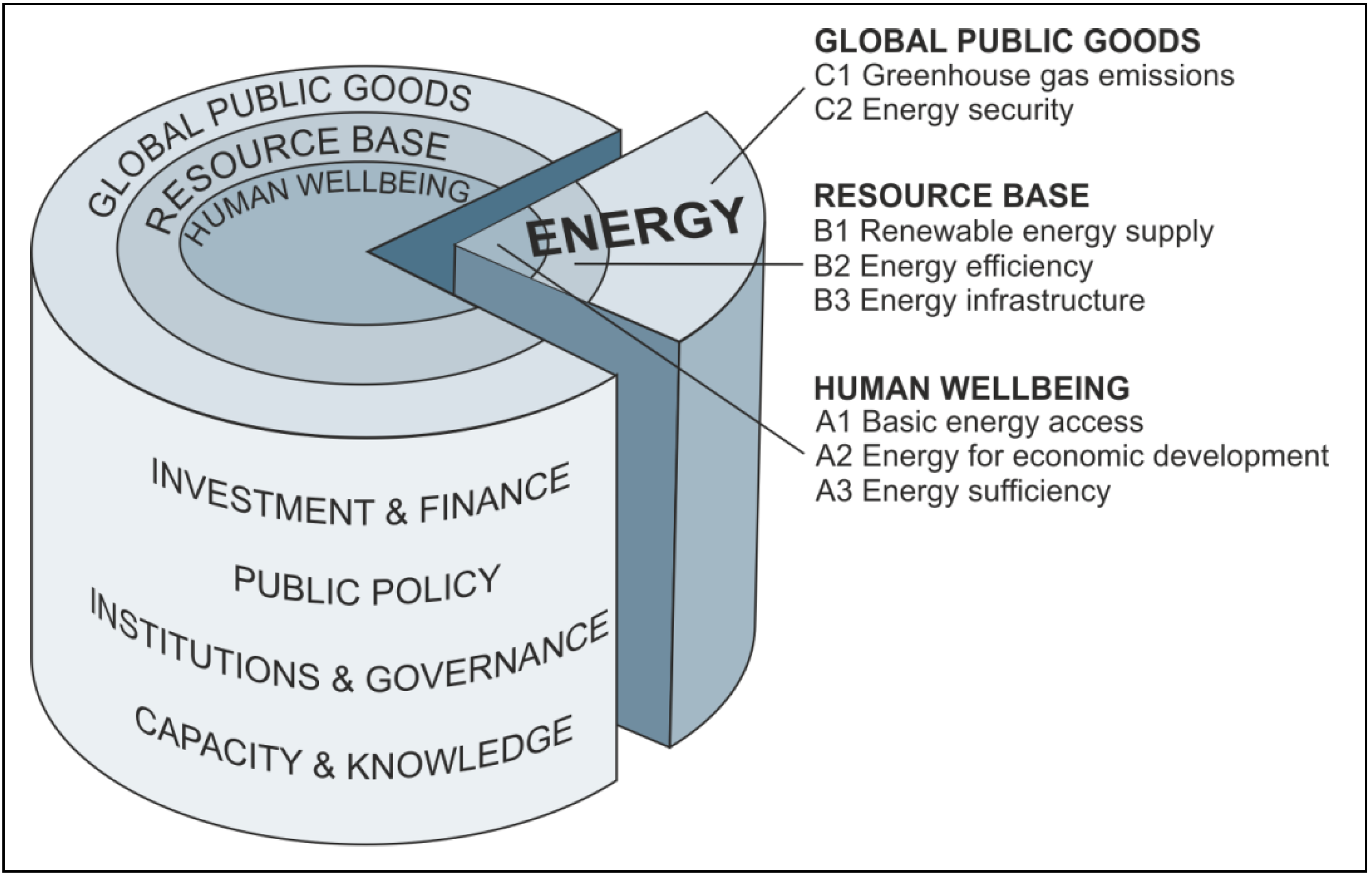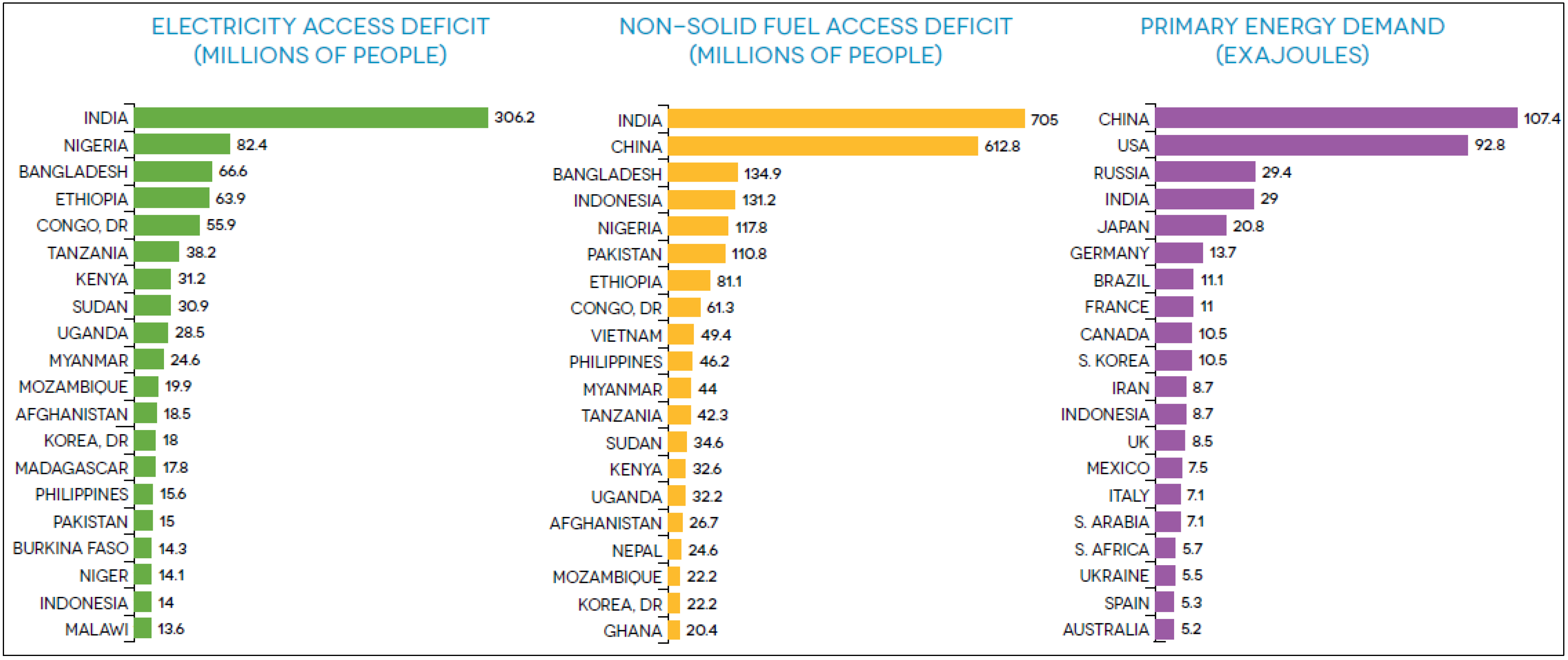Towards an Integrated Framework for SDGs: Ultimate and Enabling Goals for the Case of Energy
Abstract
:1. Introduction
2. Key Considerations for SDGs: A Three-Tiered Framework
2.1. Tier 1: Pursuing Human Wellbeing
2.2. Tier 2: Developing the Resource Base
2.3. Tier 3: Managing Global Public Goods
2.4. Enabling Goals
2.5. A Generic SDG Framework

3. Energy as a Worked Example of a Sustainable Development Goal
3.1. A: Pursuing Human Wellbeing
3.1.1. Target Area A1: Basic Energy Access
3.1.2. Target Area A2: Energy for Economic Development

3.1.3. Target Area A3: Energy Sufficiency

3.2. Resource Base
3.2.1. Target Area B1: Renewable Energy Supply
3.2.2. Target Area B2: Energy Infrastructure
3.2.3. Target Area B3: Energy Efficiency
3.3. Global Public Goods
3.3.1. Target Area C1: Greenhouse Gas Emissions
3.3.2. Target Area C2: Energy Security

4. Enabling Goals: Four Layers of Interventions to Get Us There
4.1. Capacity & Knowledge
4.2. Institutions & Governance
4.3. Public Policy
4.4. Investment & Finance
5. Examining SDG Coherence through Pathways Assessment




6. Conclusions and Implications
- A shared and universal development agenda based on human wellbeing. SDGs must be crafted in a way that is politically acceptable in the multilateral political system, where currently trust between nations has been eroded. This requires that they are rooted in common concerns and priorities. A tractable foundation, and strongly institutionalized norm, is the pursuit of human wellbeing and opportunity to prosper for all societies. An important premise for this is equality: increasing income equality over time delivers benefits directly in terms of wellbeing but is also important for economic development.
- Linking human wellbeing to the resource base and global public goods. For human wellbeing to be achievable for all and over the long term, targets must address the development of the supporting resource base. Human wellbeing and sustainability are thus tightly linked and must be integrated as development goals. This requirement is anchored in the fundamental premise that resources are scarce and the development of one actor must be pursued respecting the right of the other to access resources to develop.
- Enabling goals to complement ultimate goals should be established. We propose four key categories: capacity & knowledge development, governance & institutions, public policy, and investment & finance. These may be treated in the UN system and the broader international cooperation framework as “means of implementation”.
- Differentiation in time and space. The development challenge looks different in different countries. Priorities should be tailored from country to country, depending on resources, capacities and the level of development. Universal goals at the global level thus need to disaggregate into differential sets of specific targets for different countries. Second, targets need to be dynamic in taking into account changes and development patterns over time. For instance, when South Asia and Sub-Saharan Africa gain universal energy access, by 2030 if we meet our current goals, then they will have to move up the “energy ladder”. In the long term, strong economic development in lower-income economies will lead to both greater income equality both between and within countries and an alignment of national development agendas.
- Pathways to ensure integration and coherence: An SDG framework must be coherent so that different target areas do not counteract one another–both within a goal and between goals. This requires integration so that environment, social and economic aspects come together in each development sector rather than being treated as separate pillars. The coherence of the agenda can be tested through assessments of aggregate development pathways that articulate the technologies, practices and governance systems and enable us to trace and understand changes over time and their interactions. For example, universal basic access has already been demonstrated to be coherent with climate change mitigation, having a very marginal net effect on global greenhouse gas emissions.
Acknowledgments
Conflicts of Interest
References
- UN. The Future We Want. In Proceedings of the Rio+20 United Nations Conference on Sustainable Development, Rio de Janeiro, Brazil, 20–22 June 2012.
- Evans, A. Climate, Scarcity and Sustainability in the Post-2015 Development Agenda; New York University, Center on International Cooperation: New York, NY, USA, 2012. [Google Scholar]
- Melamed, C.; Scott, A.; Mitchel, T. Separated at Birth, Reunited in Rio? A Roadmap to Bring Environment and Development Back Together; Overseas Development Institute (ODI): London, UK, 2012. [Google Scholar]
- UNSDSN, An Action Agenda for Sustainable Development; Sustainable Development Solutions Network: New York, NY, USA, 2013.
- High-level Panel, A New Global Partnership: Eradicate Poverty and Transform Economies through Sustainable Development; United Nations: New York, NY, USA, 2013.
- High-level Panel Secretariat, People first–a Post 2015 Development Agenda. Working paper for the second HLP meeting in London. Unpublished work. 2012.
- Sachs, J.D. From millennium development goals to sustainable development goals. Lancet 2012, 379, 2206–2211. [Google Scholar] [CrossRef]
- Griggs, D.; Stafford-Smith, M.; Gaffney, O.; Rockström, J.; Öhman, M.; Shyamsundar, P.; Steffen, W.; Glaser, G.; Kanie, N.; Noble, I. Policy: Sustainable development goals for people and planet. Nature 2013, 495, 305–307. [Google Scholar] [CrossRef]
- United Nations Environment Programme (UNEP), Embedding the Environment in Sustainable Development Goals. UNEP Post-2015 Discussion Paper 1; UNEP: Nairobi, Kenya, 2013.
- Evans, A.; Steven, D. Sustainable Development Goals–a Useful Outcome from Rio+20? New York University: New York, NY, USA, 2012. [Google Scholar]
- Raworth, K. A Safe and just Space for Humanity: Can We Live inside the Doughnut? Oxfam International: London, UK, 2012. [Google Scholar]
- United Nations Global Compact (UNGC), Corporate Sustainability and the United Nations Post-2015 Development Agenda: Perspectives from UN Global Compact Participants on Global Priorities and How to Engage Business Towards Sustainable Development Goals; UNGC: New York, NY, USA, 2012.
- Bernstein, S. The Compromise of Liberal Environmentalism; Columbia University Press: New York, NY, USA, 2001. [Google Scholar]
- Kharas, H. The Emerging Middle Class in Developing Countries; OECD: Paris, France, 2010. [Google Scholar]
- Chen, S.; Ravallion, M. More Relatively-Poor People in a Less Absolutely-Poor World; Policy Research Working Paper Series 6114; The World Bank: Washington, DC, USA, 2012. [Google Scholar]
- Gewirth, A. Reason and Morality; University of Chicago Press: Chicago, IL, USA, 1978. [Google Scholar]
- Arrow, K. Social Choice and Individual Values; Wiley: New York, NY, USA, 1963. [Google Scholar]
- Dasgupta, P. Human Wellbeing and the Natural Environment; Oxford University Press: Oxford, UK, 2001. [Google Scholar]
- Sen, A. Capability and Well-Being. In The Quality of Life; Sen, A., Nussbaum, M.C., Eds.; Oxford University Press: Oxford, UK, 1993. [Google Scholar]
- Sen, A. Development as Freedom; Oxford University Press: Oxford, UK, 1999; p. 366. [Google Scholar]
- Jackson, T. Prosperity without Growth; Earthscan: London, UK, 2009. [Google Scholar]
- Martínez, D.M.; Ebenhack, B.W. Understanding the role of energy consumption in human development through the use of saturation phenomena. Energy Policy 2008, 36, 1430–1435. [Google Scholar] [CrossRef]
- Arrow, K.; Dasgupta, P.; Goulder, L.; Daily, G.; Ehrlich, P.; Heal, G.; Levin, S.; Mäler, K.G.; Schneider, S.; Starrett, D.; Walker, B. Are we consuming too much? J. Econ. Perspect. 2004, 18, 147–172. [Google Scholar] [CrossRef]
- Hamilton, C.; Denniss, R. Affluenza when too much is never Enough; Allen & Unwin: Sydney, Australia, 2005. [Google Scholar]
- Robbins, L. An Essay on the Nature and Significance of Economic Science; MacMillan and Co.: London, UK, 1935. [Google Scholar]
- Department for International Development(DFID), Sustainable Livelihoods Guidance Sheets; DFID: London, UK, 2000.
- Hamilton, K. Genuine Saving as a Sustainability Indicator; The World Bank: Washington, DC, USA, 2000; p. 15. [Google Scholar]
- Olsen, M. The Logic of Collective Action: Public Goods and the Theory of Groups; Harvard University Press: Cambridge, MA, USA, 1965. [Google Scholar]
- Crutzen, P.J.; Stoermer, E.F. The ‘anthropocene’. Glob. Change Newsl. 2000, 41, 17–18. [Google Scholar]
- Pierre, J.; Peters, G. Governing Complex Societies; Palgrave Macmillan: Basingstoke, UK, 2006. [Google Scholar]
- Van Vuuren, D.; Nakicenovic, N.; Riahi, K.; Brew-Hammond, A.; Kammen, D.; Modi, V.; Nilsson, M.; Smith, K.R. An energy vision: Transformation toward sustainability—interconnected challenges and solutions. Curr. Opin. Environ. Sustain. 2012, 4, 18–34. [Google Scholar] [CrossRef]
- The Secretary-General’s High-level Group on Sustainable Energy for All, Sustainable Energy for All: A Global Action Agenda; United Nations: New York, NY, USA, 2012.
- Global Energy Assessment(GEA), Global Energy Assessment: Towards a Sustainable Future; Cambridge University Press: Cambridge, UK, 2012.
- International Energy Agency (IEA), World Energy Outlook 2012; IEA: Paris, France, 2012.
- PBL, Roads from Rio+20: Pathways to Achieve Global Sustainability Goals by 2050; Van Vuuren, D.P.; Kok, M.T.J. (Eds.) PBL Netherlands Environmental Assessment Agency: Den Haag/Bilthoven, The Netherlands, 2012.
- Nilsson, M.; Heaps, C.; Persson, Å.; Carson, M.; Pachauri, S.; Kok, M.; Olsson, M.; Rehman, I.; Schaeffer, R.; Wood, D.; et al. Energy for a Shared Development Agenda: Global Scenarios and Governance Implications; Stockholm Environment Institute: Stockholm, Sweden, 2012. [Google Scholar]
- UN Energy, The Energy Challenge for Achieving the Millenium Development Goals; United Nations: New York, NY, USA, 2005.
- Pachauri, S.; van Ruijven, B.; Nagai, Y.; Riahi, K.; van Vuuren, D. Pathways to achieve universal household access to modern energy by 2030. Environ. Res. Lett. 2013, 8, 024015. [Google Scholar] [CrossRef]
- Lim, S.; Vos, T.; Flaxman, A.; Danaei, G.; Shibuya, K.; Adair-Rohani, H.; Amann, M.; Anderson, R.; Andrews, K:; Aryee, M.; et al. A comparative risk assessment of burden of disease and injury attributable to 67 risk factors and risk factor clusters in 21 regions, 1990–2010: A systematic analysis for the Global Burden of Disease Study 2010. Lancet 2013, 380, 2224–2260. [Google Scholar]
- International Energy Agency (IEA), Energy Poverty: How to Make Modern Energy Access Universal? Special Early Excerpt of the World Energy Outlook 2010 for the UN General Assembly on the Millennium Development Goals; IEA: Paris, France, 2010.
- Fatmi, Z.; Rahman, A.; Kazi, A.; Kadir, M.; Sathiakumar, N. Situational Analysis of Household Energy and Biomass Use and Associated Health Burden of Indoor Air Pollution and Mitigation Efforts in Pakistan. Int. J. Environ. Res. Public Health 2010, 7, 2940–2952. [Google Scholar] [CrossRef]
- Pachauri, S. Reaching an international consensus on defining modern energy access. Curr. Opin. Environ. Sustain. 2011, 3, 235–240. [Google Scholar] [CrossRef]
- AGECC, Energy for a Sustainable Future: Secretary-General’s Advisory Group on Energy and Climate Change; United Nations: New York, NY, USA, 2010.
- Goldemberg, J.; Johansson, T.B.; Reddy, A.K.N.; Williams, R.H. Basic needs and much more with one kilowatt per capita. Ambio 1985, 14, 190–200. [Google Scholar]
- Smil, V. Energy at the Crossroads. In Global Perspectives and Uncertainties; MIT Press: Cambridge, MA, USA, 2003. [Google Scholar]
- Cabraal, A.; Barnes, D.F.; Agarwal, S.G. Productive uses of energy for rural development. Annu. Rev. Environ. Resour. 2005, 30, 117–144. [Google Scholar] [CrossRef]
- Martinez, D.M.; Ebenhack, B.W. Understanding the role of energy consumption in human development through the use of saturation phenomena. Energy Policy 2008, 36, 1430–1435. [Google Scholar] [CrossRef]
- WWFand Ecofys, The Energy Report–100% Renewables by 2050; WWF: Gland, Swizerland, 2011.
- Girod, B.; van Vuuren, D.P.; de Vries, B. Influence of Travel Behavior on Global CO2 Emissions. Transport. Res. A-Pol. 2013, 50, 183–197. [Google Scholar]
- Steinberger, J.K.; Roberts, J.T. From constraint to sufficiency. The decoupling of energy and carbon from human needs, 1975–2005. Ecol. Econ. 2010, 70, 425–433. [Google Scholar] [CrossRef]
- REN21, Global Status Report for 2012; REN21 Secretariat: Paris, France, 2012.
- Riahi, K.; Dentener, F.; Gielen, D.; Grubler, A.; Jewell, J.; Klimont, Z.; Krey, V.; McCollum, D.L.; Pachauri, S.; Rao, S.; et al. Energy Pathways for Sustainable Development. In The Global Energy Assessment: Toward a More Sustainable Future; Cambridge University Press: Cambridge, UK, 2012. [Google Scholar]
- Rogelj, J.; McCollum, D.L.; Riahi, K. The UN’s ‘Sustainable Energy for All’ initiative is compatible with a warming limit of 2 °C. Nat. Clim. Change 2013, 3, 545–551. [Google Scholar]
- Luderer, G.; Krey, V.; Calvin, K.; Merrick, J.; Mima, S.; Pietzcker, R.C.; van Vliet, J.; Wada, K. The role of renewable energy in climate stabilization: results from the EMF27 scenarios. Clim. Change 2013, in press. [Google Scholar]
- Van Vuuren, D.P.; Riahi, K. The relationship between short-term emissions and long-term concentration targets—A letter. Clim. Change 2011, 104, 793–801. [Google Scholar] [CrossRef]
- Intergovernmental Panel on Climate Change (IPCC), Special Report on Renewable Energy Sources and Climate Change Mitigation; IPCC: Bonn, Germany, 2011.
- Bringezu, S.; Schutz, H.; O’Brien, M.; Kauppi, L.; Howarth, R.; McNeely, J. Assessing Biofuels; UNEP–International Panel for Sustainable Resource Management: Paris, France, 2009. [Google Scholar]
- Van Vuuren, D.P.; van Vliet, J.; Stehfest, E. Future bio-energy potential under various natural constraints. Energy Policy 2009, 37, 4220–4230. [Google Scholar] [CrossRef]
- Van Vuuren, D.P.; Bellevrat, E.; Kitous, A.; Isaac, M. Bio-energy use and low stabilization scenarios. The economics of low stabilization. Energy J. 2010, 31, 193–222. [Google Scholar]
- Girod, B.; van Vuuren, D.P.; Hertwich, E.G. Global climate targets and future consumption level: An evaluation of the required GHG intensity. Environ. Res. Lett. 2013, 8, 014016. [Google Scholar] [CrossRef]
- UNFCCC. Copenhagen Accord: Proposal by the President, United Nations Framework Convention on Climate Change (UNFCCC). Available online: http://www.unfccc.int/resource/docs/2009/cop15/eng/l07.pdf (accessed on 19 August 2013).
- United Nations Framework Convention on Climate Change (UNFCCC), Decision 1/CP.16: The Cancun Agreements: Outcome of the work of the Ad Hoc Working Group on Long-term Cooperative Action under the Convention. 2010.
- Rogelj, J.; Meinshausen, M.; Knutti, R. Emission pathways consistent with a 2 °C global temperature limit. Nat. Clim. Change 2011, 1, 413–418. [Google Scholar] [CrossRef]
- Goldthau, A. A public policy perspective on global energy security. Int. Stud. Perspect. 2012, 12, 65–84. [Google Scholar] [CrossRef]
- Abbott, M. Is the security of electricity supply a public good? Electr. J. 2001, 14, 31–33. [Google Scholar] [CrossRef]
- Kruyt, B.; van Vuuren, D.P.; de Vries, H.J.M.; Groenenberg, H. Indicators for energy security. Energy Policy 2009, 37, 2166–2181. [Google Scholar] [CrossRef]
- IEA, Energy Security and Climate Policy- Assessing Interactions; IEA/OECD: Paris, France, 2007.
- CEC, Communication from the Commission: Making the Internal Energy Market Work COM/2012/0663; European Commission: Brussels, Belgium, 2012.
- IMF, Energy Subsidy Reform; International Monetary Fund: Washington, DC, USA, 2013.
- Frankfurt School UNEP Collaborating Centre for Climate and Sustainable Energy Finance, Global Trends in Renewable Energy Investment 2012; Frankfurt School of Finance and Management: Frankfurt, Germany, 2012.
- IEA, Energy Technology Perspectives 2012; International Energy Agency: Paris, France, 2012.
- Nilsson, M.; Zamparutti, T.; Petersen, J.E.; Nykvist, B.; Rudberg, P.; McGuinn, J. Understanding policy coherence: analytical framework and examples of sector-environment policy interactions in the EU. Environ. Policy Gov. 2012, 22, 395–423. [Google Scholar] [CrossRef]
- World Bank, Global Tracking Framework; World Bank: Washington, DC, USA, 2013.
- Bazilian, M.; Pielke, R. Making energy access meaningful. Issues Sci. Technol. 2013, Summer, pp. 74–79. Available online: http://sciencepolicy.colorado.edu/admin/publication_files/2013.22.pdf (accessed on 1 September 2013).
© 2013 by the authors; licensee MDPI, Basel, Switzerland. This article is an open access article distributed under the terms and conditions of the Creative Commons Attribution license (http://creativecommons.org/licenses/by/3.0/).
Share and Cite
Nilsson, M.; Lucas, P.; Yoshida, T. Towards an Integrated Framework for SDGs: Ultimate and Enabling Goals for the Case of Energy. Sustainability 2013, 5, 4124-4151. https://doi.org/10.3390/su5104124
Nilsson M, Lucas P, Yoshida T. Towards an Integrated Framework for SDGs: Ultimate and Enabling Goals for the Case of Energy. Sustainability. 2013; 5(10):4124-4151. https://doi.org/10.3390/su5104124
Chicago/Turabian StyleNilsson, Måns, Paul Lucas, and Tetsuro Yoshida. 2013. "Towards an Integrated Framework for SDGs: Ultimate and Enabling Goals for the Case of Energy" Sustainability 5, no. 10: 4124-4151. https://doi.org/10.3390/su5104124



